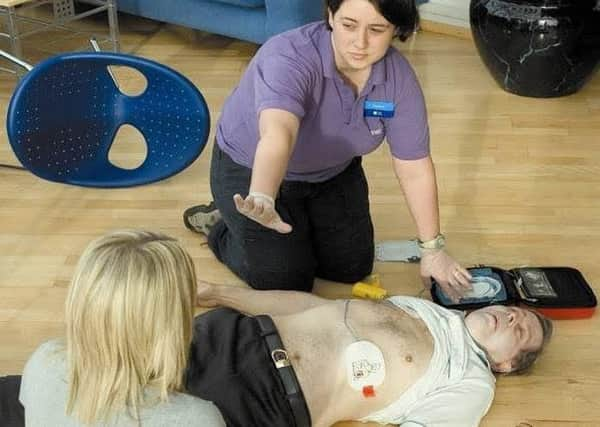ST JOHN AMBULANCE: How to use an automated external defibrillator


An AED is an important piece of equipment that can save lives in the minutes after someone suffers a cardiac arrest.
The earlier a casualty is defibrillated, the greater the chance of their survival and these machines are becoming more widely available in public places such as shopping centres, railway stations and airports.
Advertisement
Hide AdAdvertisement
Hide AdThe machine analyses the casualty’s heart rhythm and tells you with voice prompts what to do.
If the casualty is unresponsive and breathing is absent or agonal, prepare to use the AED.
If possible, ensure that someone is performing CPR as you do this and get someone to call 999/112 for emergency help.
Position the AED beside the casualty.
Remove any metal jewellery or medication patches from the casualty but this should not delay the application of the AED.
Turn on the AED and follow the voice prompts.
Advertisement
Hide AdAdvertisement
Hide AdRemove the electrode pads from their sealed packets and place them on the casualty’s bare chest following the instructions given with the pads.
The voice prompts will instruct you not to touch the casualty. Instruct everyone to stand clear and check that no-one is touching the casualty. Any CPR being performed should stop.
The AED will analyse the casualty’s heart rhythm and, if a shock is necessary, the machine will charge and issue a voice prompt.
Before giving the shock, double check that no-one is touching the casualty. Press the ‘Shock’ button on the AED.
Advertisement
Hide AdAdvertisement
Hide AdWhen the shock is delivered the casualty will jump – this is normal.
Keep following the voice prompts from the AED. Do not give up if the first shock seems ineffective.
• For those looking for quick, easily accessible first aid information, the St John Ambulance app is available free on smartphones and the website (www.sja.org.uk) offers demo videos, an interactive game, and lots of free advice. For more information about first aid courses please call 0303 003 0101.
---
Don’t miss out on all the latest breaking news where you live.
Advertisement
Hide AdAdvertisement
Hide AdHere are four ways you can be sure you’ll be amongst the first to know what’s going on.
1) Make our website your homepage
2) Like our Facebook page
3) Follow us on Twitter
4) Register with us by clicking on ‘sign in’ (top right corner). You can then receive our daily newsletter AND add your point of view to stories that you read here.
And do share with your family and friends - so they don’t miss out!
Always the first with your local news.
Be part of it.